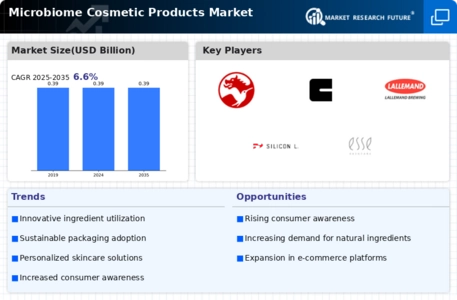Regulatory Support
Regulatory support for microbiome cosmetic products is emerging as a key driver in the Global Microbiome Cosmetic Products Industry. Governments and regulatory bodies are beginning to recognize the potential benefits of microbiome research in cosmetics, leading to the establishment of guidelines that promote safe and effective formulations. This regulatory framework not only enhances consumer confidence but also encourages manufacturers to invest in microbiome-focused research. As the industry matures, the alignment of regulations with scientific advancements may facilitate market growth, ensuring that products meet safety and efficacy standards.
Sustainability Trends
Sustainability trends significantly influence the Global Microbiome Cosmetic Products Industry, as consumers increasingly prioritize eco-friendly and ethically sourced products. Brands that adopt sustainable practices in their production processes and ingredient sourcing are likely to resonate with environmentally conscious consumers. This shift towards sustainability is reflected in the development of microbiome products that utilize natural and organic ingredients, reducing the environmental impact. As the market evolves, companies that successfully integrate sustainability into their microbiome offerings may gain a competitive edge, fostering brand loyalty and driving sales.
Market Growth Projections
Global Microbiome Cosmetic Products Industry is poised for steady growth, with projections indicating a market size of 0.39 USD Billion by 2035. Despite a CAGR of 0.0% for the period between 2025 and 2035, the market is expected to maintain its value, reflecting a stable demand for microbiome-based products. This stability may be attributed to the ongoing consumer interest in skincare solutions that promote microbiome health. As brands continue to innovate and adapt to consumer preferences, the market is likely to sustain its relevance in the broader cosmetic landscape.
Rising Consumer Awareness
The Global Microbiome Cosmetic Products Industry experiences a notable increase in consumer awareness regarding skin health and microbiome benefits. As individuals become more informed about the importance of maintaining a balanced skin microbiome, demand for microbiome-friendly products surges. This trend is evidenced by the growing popularity of products that emphasize natural ingredients and probiotic formulations. The market is projected to reach 0.39 USD Billion in 2024, reflecting a shift towards products that promote skin health through microbiome support. Such awareness drives innovation and encourages brands to develop formulations that cater to this emerging consumer preference.
Innovation in Formulations
Innovation plays a crucial role in the Global Microbiome Cosmetic Products Market as brands increasingly invest in research and development to create advanced formulations. The incorporation of prebiotics, probiotics, and postbiotics into cosmetic products enhances their appeal and efficacy. This innovation not only addresses consumer demands for effective skincare solutions but also aligns with the growing trend of personalized beauty. As companies strive to differentiate themselves in a competitive landscape, the introduction of unique microbiome-centric products is likely to attract a broader customer base, potentially contributing to market growth.
















Leave a Comment